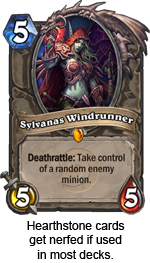Trending
Opinion: How will Project 2025 impact game developers?
The Heritage Foundation's manifesto for the possible next administration could do great harm to many, including large portions of the game development community.

Featured Blog | This community-written post highlights the best of what the game industry has to offer. Read more like it on the Game Developer Blogs or learn how to Submit Your Own Blog Post
Game balancing is fascinating for game designers, so much that we often rush to our beloved spreadsheets and forget the big picture. Here are my tips on how to approach game balancing and best support your game vision.

Game balancing is key for game design. Finding the exact damage value for a weapon or the correct height for the jump of a character is exciting for game designers because it’s about the only moment where we can immediately see the impact of our decisions.
This feedback loop is so rewarding it can trick us into endless tweaking, tinkering and fiddling of spreadsheets. Focusing so much on details can often make us forget the big picture, and I want to give you my tips on how to approach game balancing.
Before going into more details, here is my short video on the subject.
The most important notion is that elements of a game are meaningless on their own, as the player will never encounter them in a vacuum. An ability will always be confronted by obstacles. For gameplay to feel good, player tools must seem adapted to the challenge they help overcome.  This lets players develop a consistent understanding of the game and leads to “aha moments” as they recognize patterns in the obstacles and know what ability to use.
This lets players develop a consistent understanding of the game and leads to “aha moments” as they recognize patterns in the obstacles and know what ability to use.
The first level of Super Mario Bros proposes obstacles exactly matched to Mario’s jump, in height and length. This teaches the player the parameters of the key ability, and will allow to clearly evaluate options in navigating each level.
Games are systems of elements in interaction, and a dynamic always emerges from the ensemble. Because you want to give players a seamless experience interacting with your game dynamic, you should decide upon it first, then use this target to evaluate your balancing effort. It is the role of design to determine these interactions, and of game balancing to set parameters so things unfold as desired.
Another way to make a tool particularly adapted to a situation is to make it way more efficient compared to the others. Think of the classic RTS unit type cycle infantry/archer/cavalry, or even rock/paper/scissors. Once again, it is the clarity or the relationship that creates a satisfactory decision for players because it lets them learn more easily.
This illustrates the notion that game balancing is generally not about making the different elements equal, but rather creating strong discrepancies leading to clear dynamics and relationships.
 With many moving parts, it is possible that strategies becomes way stronger than expected, to the point of making all other options useless, what game theory calls dominant strategies. If your gameplay relies on selecting the best approach, this will definitely hurt the depth of the decision process as well as gameplay variety.
With many moving parts, it is possible that strategies becomes way stronger than expected, to the point of making all other options useless, what game theory calls dominant strategies. If your gameplay relies on selecting the best approach, this will definitely hurt the depth of the decision process as well as gameplay variety.
In this case, you want to reduce the effectiveness of the elements that give so much strength to this strategy (also called nerfing) and make multiple options viable again. This will bring value back in the decision process by proposing a dilemma where all options are clear, the right one being uncertain (cf. Fun and uncertainty).
Very frequently, unforeseen strategies will divert from intended gameplay. On a shipped game, this will be called an exploit, but it can be addressed to some extend during development. If the testing team is given a list of the desired winning strategies for each situation, it will be able to validate that the intention is maintained, and verify that other options don’t unduly dominate.
Skill is very important when trying to basically break intended gameplay, this is why our balance testers at Relic were competitive level players. This type of workflow, makes the team able to evaluate the strength of the gameplay structure, find loopholes, and decide to react accordingly, or to leave these options available.
Also read: Fun and uncertainty – The importance of uncertain outcomes for fun.
When Street Fighter II was developed, the team incorporated leniency to make special moves easier to execute, but a side effect made it possible to create unplanned combos. They viewed this as an interesting features and decided to keep it, which opened up some pretty dominating strategies. From there, it got refined and became the key mechanic of the whole fighting genre. This shows that we shouldn’t discard the value of emergence.
The team got pretty lucky to create such a successful gameplay through what was almost an oversight. This is why I think that an intentional approach is superior to better control the resulting game dynamic. Defining a clear target for gameplay then feeds into the game balancing process. It allows to evaluate the different strategies that emerge, and make informed and rational decisions before rushing to our beloved spreadsheets.
Also read: Assassin's creed combat – Adapting design to a mass audience.
My website - My Youtube channel - My Twitter
References:
Clint Tasker, The zealot and the zergling
Blizzard forums, Hearthstone’s card balance philosophy
Game Whispering, Understanding gameplay – Part two: Technique
Game Whispering, Fun and uncertainty
Read more about:
Featured BlogsYou May Also Like